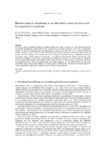Mostrar o rexistro simple do ítem
Human amniotic membrane as an alternative source of stem cells for regenerative medicine
| dc.contributor.author | Díaz-Prado, Silvia | |
| dc.contributor.author | Muiños-López, Emma | |
| dc.contributor.author | Hermida Gómez, Tamara | |
| dc.contributor.author | Cicione, Claudia | |
| dc.contributor.author | Rendal Vázquez, María Esther | |
| dc.contributor.author | Fuentes Boquete, Isaac Manuel | |
| dc.contributor.author | De-Toro, Javier | |
| dc.contributor.author | Blanco García, Francisco J | |
| dc.date.accessioned | 2015-06-16T10:46:18Z | |
| dc.date.available | 2015-06-16T10:46:18Z | |
| dc.date.issued | 2011-02-19 | |
| dc.identifier.citation | Díaz-Prado S, Muíños-López S, Hermida-Gómez T, Ciccione C, Rendal-Vázquez ME, Fuentes-Boquete I, et al. Human amniotic membrane as an alternative source of stem cells for regenerative medicine. Differentiation. 2011;81(3):162-171. | es_ES |
| dc.identifier.uri | http://hdl.handle.net/2183/14683 | |
| dc.description.abstract | [Abstract] The human amniotic membrane (HAM) is a highly abundant and readily available tissue. This amniotic tissue has considerable advantageous characteristics to be considered as an attractive material in the field of regenerative medicine. It has low immunogenicity, anti-inflammatory properties and their cells can be isolated without the sacrifice of human embryos. Since it is discarded post-partum it may be useful for regenerative medicine and cell therapy. Amniotic membranes have already been used extensively as biologic dressings in ophthalmic, abdominal and plastic surgery. HAM contains two cell types, from different embryological origins, which display some characteristic properties of stem cells. Human amnion epithelial cells (hAECs) are derived from the embryonic ectoderm, while human amnion mesenchymal stromal cells (hAMSCs) are derived from the embryonic mesoderm. Both populations have similar immunophenotype and multipotential for in vitro differentiation into the major mesodermal lineages, however they differ in cell yield. Therefore, HAM has been proposed as a good candidate to be used in cell therapy or regenerative medicine to treat damaged or diseased tissues. | es_ES |
| dc.description.sponsorship | This study was supported by grants: Servizo Galego de Saúde, Xunta de Galicia (PS07/84), Cátedra Bioiberica de la Universidade da Coruña and Instituto de Salud Carlos III CIBER BBN CB06-01-0040; Ministerio Ciencia en Innovacion PLE2009-0144; Fondo Investigacion Sanitaria-PI 08/2028 with participation of fundus from FEDER (European Community), Silvia Diaz-Prado is beneficiary of an Isidro Parga Pondal contract from Xunta de Galicia, A Coruna, Spain. | es_ES |
| dc.description.sponsorship | Instituto de Salud Carlos III; CB06-01-0040 | |
| dc.description.sponsorship | info:eu-repo/grantAgreement/MICINN/Programa Nacional de Internacionalización de la I+D/PLE2009-0144/ES/In situ Tissue Engineering using Stem Cells and Functional Biomaterials to Repair Articular Cartilage: An ''in Vivo Model" | |
| dc.description.sponsorship | Xunta de Galicia; PS07/84 | |
| dc.description.sponsorship | Instituto de Salud Carlos III; PI 08/2028 | |
| dc.language.iso | eng | es_ES |
| dc.publisher | Elsevier | es_ES |
| dc.relation.uri | http://dx.doi.org/10.1016/j.diff.2011.01.005 | es_ES |
| dc.rights | Creative Commons Attribution-NonCommercial-NoDerivs 4.0 International Licence (CC-BY-NC-ND 4.0) | es_ES |
| dc.rights.uri | http://creativecommons.org/licenses/by-nc-nd/4.0/ | |
| dc.subject | Amniotic membrane | es_ES |
| dc.subject | Mesenchymal stem cell | es_ES |
| dc.subject | Cartilage | es_ES |
| dc.subject | Osteoarthritis | es_ES |
| dc.subject | Differentiation pluripotent | es_ES |
| dc.subject | Amnionderived cells | es_ES |
| dc.title | Human amniotic membrane as an alternative source of stem cells for regenerative medicine | es_ES |
| dc.type | info:eu-repo/semantics/article | es_ES |
| dc.rights.access | info:eu-repo/semantics/openAccess | es_ES |
Ficheiros no ítem
Este ítem aparece na(s) seguinte(s) colección(s)
-
GI-TCMR - Artigos [123]
-
INIBIC-TCMR - Artigos [102]
-
INIBIC- REUMA - Artigos [182]






